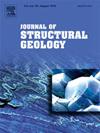Lateral growth, linkage and driving force of anticlines in the western Qaidam Basin, Northern Tibetan Plateau
IF 2.9
2区 地球科学
Q2 GEOSCIENCES, MULTIDISCIPLINARY
引用次数: 0
Abstract
In fold-and-thrust belts, folds usually grow laterally, and connect with neighboring folds to form larger structures. Whilst these processes significantly impact both the surface morphology and subsurface structures, there remains a gap in understanding the deep deformation involved in lateral growth and linkage of folds. To address this issue, our study focused on the northwestern Qaidam Basin hosting a series of well-exposed NW-SE-trending Cenozoic anticlines. We conducted a comprehensive analysis of the lateral growth and linkage patterns along with their subsurface structures of the anticlines, based on high-resolution remote-sensing images and seismic reflection data. Our investigation reveals that the anticlines are primarily décollement folds, with minor influence from basement-involved reverse faults. They have grown through lateral lengthening from their nuclei, with a generally faster propagation rate toward the southeast. This growth pattern is likely driven by the southeastward decrease in strain rate, coupled with the influence from southeastward tilting of the basement and topography in the Qaidam Basin. We identify six types of lateral linkage among anticlines in the Qaidam Basin: linear linkage, linear repulsion, oblique linkage, overlapped linkage, oblique non-linkage, and triple linkage. Notably, our study reports, for the first time, instances of linear repulsion and overlapped linkage, characterized by abnormally large distance to wavelength ratios. The development of linear repulsion is associated with the buried basement-involved fault between linked anticlines, whereas that of overlapped linkage likely results from rapid lateral growth of anticlines due to intense wind erosion. Moreover, our findings indicate that the en echelon-like distribution and arcuate shapes of the anticlines in the Qaidam Basin primarily stem from the lateral growth and linkage of the short-axis anticlines, rather than inferred basement strike-slip shears. The underlying driving force is the compression from the Qiman Tagh-East Kunlun Shan and the South Qilian Shan to the south and north, respectively. Our study underscores the interplay of décollements, basement-involved faults and erosional processes in shaping the diverse growth and linkage patterns of anticlines in fold-and-thrust belts.
青藏高原北部柴达木盆地西部背斜横向生长、联动与驱动力
在褶皱冲断带中,褶皱通常是横向生长的,并与相邻褶皱连接形成较大的构造。虽然这些过程对地表形态和地下结构都有显著影响,但在了解褶皱横向生长和联系所涉及的深层变形方面仍然存在空白。为了解决这一问题,我们将研究重点放在了柴达木盆地西北部一系列发育良好的nw - se向新生代背斜上。基于高分辨率遥感影像和地震反射资料,对背斜的横向生长、联动模式及其地下构造进行了综合分析。研究表明,背斜主要为反褶褶皱,受基底逆断层影响较小。它们从核向外侧伸长生长,向东南方向的繁殖速度一般较快。这种生长模式可能是受应变速率东南减小的影响,再加上基底东南倾斜和柴达木盆地地形的影响。研究发现柴达木盆地背斜中存在6种侧向联动类型:线性联动、线性排斥联动、倾斜联动、重叠联动、倾斜非联动和三重联动。值得注意的是,我们的研究首次报告了线性排斥和重叠链接的实例,其特征是异常大的距离波长比。线状排斥力的发育与连接背斜之间的隐埋基底断层有关,而重叠联系的发育则可能是由于强烈的风蚀作用导致背斜横向快速生长所致。此外,柴达木盆地背斜呈雁梯状分布和弧形主要是由于短轴背斜的横向生长和联系,而非推断出的基底走滑剪切作用。祁曼塔格—东昆仑山和南祁连山分别向南和向北挤压是其潜在驱动力。我们的研究强调了在褶皱冲断带背斜的不同生长模式和联系模式中,杂环、基底断层和侵蚀过程的相互作用。
本文章由计算机程序翻译,如有差异,请以英文原文为准。
求助全文
约1分钟内获得全文
求助全文
来源期刊

Journal of Structural Geology
地学-地球科学综合
CiteScore
6.00
自引率
19.40%
发文量
192
审稿时长
15.7 weeks
期刊介绍:
The Journal of Structural Geology publishes process-oriented investigations about structural geology using appropriate combinations of analog and digital field data, seismic reflection data, satellite-derived data, geometric analysis, kinematic analysis, laboratory experiments, computer visualizations, and analogue or numerical modelling on all scales. Contributions are encouraged to draw perspectives from rheology, rock mechanics, geophysics,metamorphism, sedimentology, petroleum geology, economic geology, geodynamics, planetary geology, tectonics and neotectonics to provide a more powerful understanding of deformation processes and systems. Given the visual nature of the discipline, supplementary materials that portray the data and analysis in 3-D or quasi 3-D manners, including the use of videos, and/or graphical abstracts can significantly strengthen the impact of contributions.
 求助内容:
求助内容: 应助结果提醒方式:
应助结果提醒方式:


